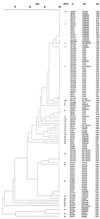Evaluation of pulsed-field gel electrophoresis in epidemiological investigations of meningococcal disease outbreaks caused by Neisseria meningitidis serogroup C
- PMID: 11136752
- PMCID: PMC87683
- DOI: 10.1128/JCM.39.1.75-85.2001
Evaluation of pulsed-field gel electrophoresis in epidemiological investigations of meningococcal disease outbreaks caused by Neisseria meningitidis serogroup C
Abstract
Since 1990, the frequency of Neisseria meningitidis serogroup C (NMSC) outbreaks in the United States has increased. Based on multilocus enzyme electrophoresis (MEE), the current molecular subtyping standard, most of the NMSC outbreaks have been caused by isolates of several closely related electrophoretic types (ETs) within the ET-37 complex. We chose 66 isolates from four well-described NMSC outbreaks that occurred in the United States from 1993 to 1995 to evaluate the potential of pulsed-field gel electrophoresis (PFGE) to identify outbreak-related isolates specific for each of the four outbreaks and to differentiate between them and 50 sporadic isolates collected during the outbreak investigations or through active laboratory-based surveillance from 1989 to 1996. We tested all isolates collected during the outbreak investigations by four other molecular subtyping methods: MEE, ribotyping (ClaI), random amplified polymorphic DNA assay (two primers), and serotyping and serosubtyping. Among the 116 isolates, we observed 11 clusters of 39 NheI PFGE patterns. Excellent correlation between the PFGE and the epidemiological data was observed, with an overall sensitivity of 85% and specificity of 71% at the 95% pattern relatedness breakpoint using either 1.5 or 1.0% tolerance. For all four analyzed outbreaks, PFGE would have given public health officials additional support in declaring an outbreak and making appropriate public health decisions.
Figures






References
-
- Achtman M. Epidemic spread and antigenic variability of Neisseria meningitidis. Trends Microbiol. 1995;3:186–192. - PubMed
-
- Bygraves J A. Analysis of the clonal relationships between strains of Neisseria meningitidis by pulsed field gel electrophoresis. J Gen Microbiol. 1992;138:523–531. - PubMed
-
- Caugant D A. Population genetics and molecular epidemiology of Neisseria meningitidis. APMIS. 1998;106:505–525. - PubMed
Publication types
MeSH terms
LinkOut - more resources
Full Text Sources

